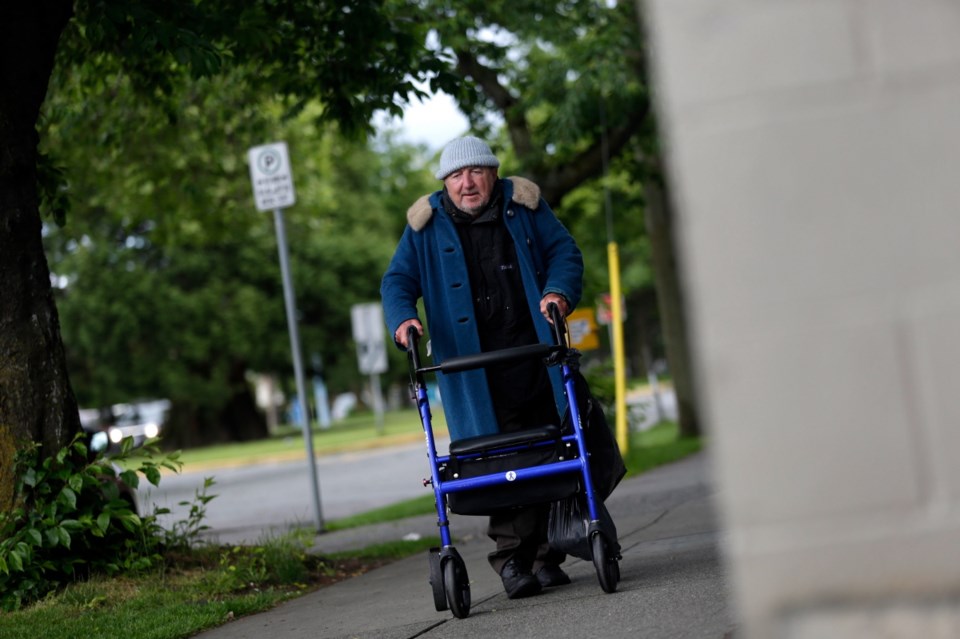The morning chill is lingering in the downtown park as 75-year-old Gwyn Rees carefully balances a cup of coffee on his walker and accepts a cheese sandwich and doughnut to help sop up the sherry he will sip for the rest of the day.
“I’m living outside on the streets and, even though it’s summertime, it’s damp and cold,” says Rees, pulling his woollen hat farther over his brow.
Despite a rough night on the sidewalk, his beard is neatly clipped and, as he fixes people with a direct stare, he fires off general knowledge questions in a distinctly British accent.
“I’m not English, I’m Welsh,” he says fiercely when asked about his background.
But for decades, Rees has lived and worked in Canada, and now, with his legs giving out, no housing, and shelters turning him away, age and physical problems are catching up.
Rees is representative of a growing population of homeless seniors in Victoria, says Rev. Al Tysick of the Dandelion Society, who advocates for people who are extremely hard to house.
“This is just the tip of the iceberg. There’s a big hole in the fabric of the safety net,” he says. “Here we are in Victoria with a 75-year-old man, and we can’t seem to house him.”
Figures from the Greater Victoria Coalition to End Homelessness show that seniors comprised 12 per cent of the street population in 2011-12 — an increase from eight per cent in 2008-09.
Rees has a problem with sherry — sipped slowly through the day rather than binging — he is occasionally incontinent and needs someone with him if he showers, which makes life tough in a shelter, Tysick says.
“The more he drinks, the less mobility he has. He goes to Alcoholics Anonymous every day to try and battle it. … We are not talking about a violent man,” Tysick says.
Rees is not welcome at Vancouver Island Health Authority’s Sobering Centre or the Salvation Army Addictions and Rehabilitation Centre, and Our Place, which offers meals and a drop-in centre, is closed at night.
Kyla Ferns, Salvation Army spokeswoman, says there are strict rules in the shelter around behaviour.
“And we have zero tolerance for drugs and alcohol,” she says.
John Braun, VIHA manager of mental health and substance abuse, says that despite outreach teams trying to find solutions, it is sometimes tough to find appropriate levels of housing, especially if someone has alcohol or behaviour problems. “Sometimes it’s better to have non-staffed housing with the ACT [Assertive Community Treatment] team or homecare coming in,” he says.
However, all organizations acknowledge there is a critical shortage of affordable housing in Victoria.
Tysick would like to see the health authority and community organizations come together to find Rees a place to live and then provide him with the support he needs. “I know I can’t leave him much longer. We need to pull together a community plan.”
Life has not always been this way, says Rees, who collects a pension, but has not been able to find steady housing since walking out of Cool Aid Society’s Fairway Woods supported housing in Langford in 2008.
“I am a chartered accountant, an ex-millionaire, a pilot, a professional fisherman and I’ve had many other adventures,” he says.
Rees would ideally like a market-rent apartment with home-visit supports. “Or I would love to live on Saltspring Island and raise sheep.”
It is economically — as well as socially — necessary to house homeless seniors, says Tysick, running through services provided to Rees the previous day.
Rees was found lying on the grass in Quadra Park and police took him to the Salvation Army, but he was “beyond their care.”
The next stop was Our Place, but it was after hours and he fell asleep on the sidewalk, where a Good Samaritan called an ambulance.
“At the hospital, they X-rayed his leg and told him to get out,” Tysick says.
“They gave him a bus ticket downtown and then he walked back to Our Place and I discovered him there in the morning. … Look at the cost of being picked up by the police and ambulance in one night.”
It felt like a night of rejections, Rees says.
“I always thought hospitals were supposed to relieve pain and suffering, but the doctor said the hospital was not a hotel.”



